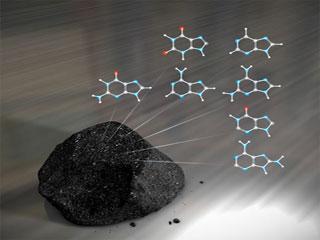
Meteorites contain a large variety of nucleobases, an essential building block of DNA. Photo: NASA's Goddard Space Flight Center/Chris Smith
WASHINGTON (PTI): Scientists have found components of DNA, the building blocks of life on Earth, in meteorites, a discovery they say confirms the theory that at least some of the materials needed to make early life forms came to our planet from space.
In the NASA-funded study, published in the Proceedings of the National Academy of Sciences, scientists used advanced mass spectrometry instruments to scan 11 organic-rich meteorites called carbonaceous chondrites and one ureilite, a very rare meteorite with a different chemical composition.
They found three nucleobases -- purine, 6,8-diaminopurine and 2,6-diaminopurine -- that are widely distributed in carbonaceous chondrites and which are "rare or absent in terrestrial biology," said the researchers.
The scientists found no significant concentrations of the trio in soil and ice samples near where the meteorites landed, LiveScience reported.
Past research had revealed a range of building blocks of life in meteorites, such as the amino acids that make up proteins. Space rocks just like these may have been a vital source of the organic compounds that gave rise to life on Earth.
This was the first time all but two of these meteorites had been analysed for nucleobases, the researchers said.
"People have been finding nucleobases in meteorites for about 50 years now, and have been trying to figure out if they are of biological origin or not," said study co-author Jim Cleaves, of the Carnegie Institution of Washington.
"Finding nucleobase compounds not typically found in Earth's biochemistry strongly supports an extraterrestrial origin.
"This shows us that meteorites may have been molecular tool kits, which provided the essential building blocks for life on Earth," Cleaves was quoted as saying to SPACE.com.
The analytical techniques probed the mass and other features of the molecules to identify the presence of extraterrestrial nucleobases and see that they apparently did not come from the surrounding area.
Two of the carbonaceous chondrites contained a diverse array of nucleobases and structurally similar compounds known as nucleobase analogs.
Intriguingly, three of these nucleobase analogs are very rare in Earth biology, and were not found in soil and ice samples from the areas near where the meteorites were collected at the parts-per-billion limits of their detection techniques, the researchers said.
"At the start of this project, it looked like the nucleobases in these meteorites were terrestrial contamination, these results were a very big surprise for me," said study co-author Michael Callahan, an astrobiologist at NASA Goddard Space Flight Center.
Lab experiments showed that chemical reactions of ammonia and cyanide, compounds that are common in space, could generate nucleobases and nucleobase analogs very similar to those found in the carbonaceous chondrites.
However, the relative abundances of these molecules between the experiments and the meteorites differed, which might be due to further chemical and thermal influences from space.
The findings suggest the earliest forms of life on Earth may have been assembled from materials delivered to Earth by meteorites, the researchers added.
 Previous Article
Previous Article Next Article
Next Article












The Indian Air Force, in its flight trials evaluation report submitted before the Defence Ministry l..
view articleAn insight into the Medium Multi-Role Combat Aircraft competition...
view articleSky enthusiasts can now spot the International Space Station (ISS) commanded by Indian-American astr..
view article